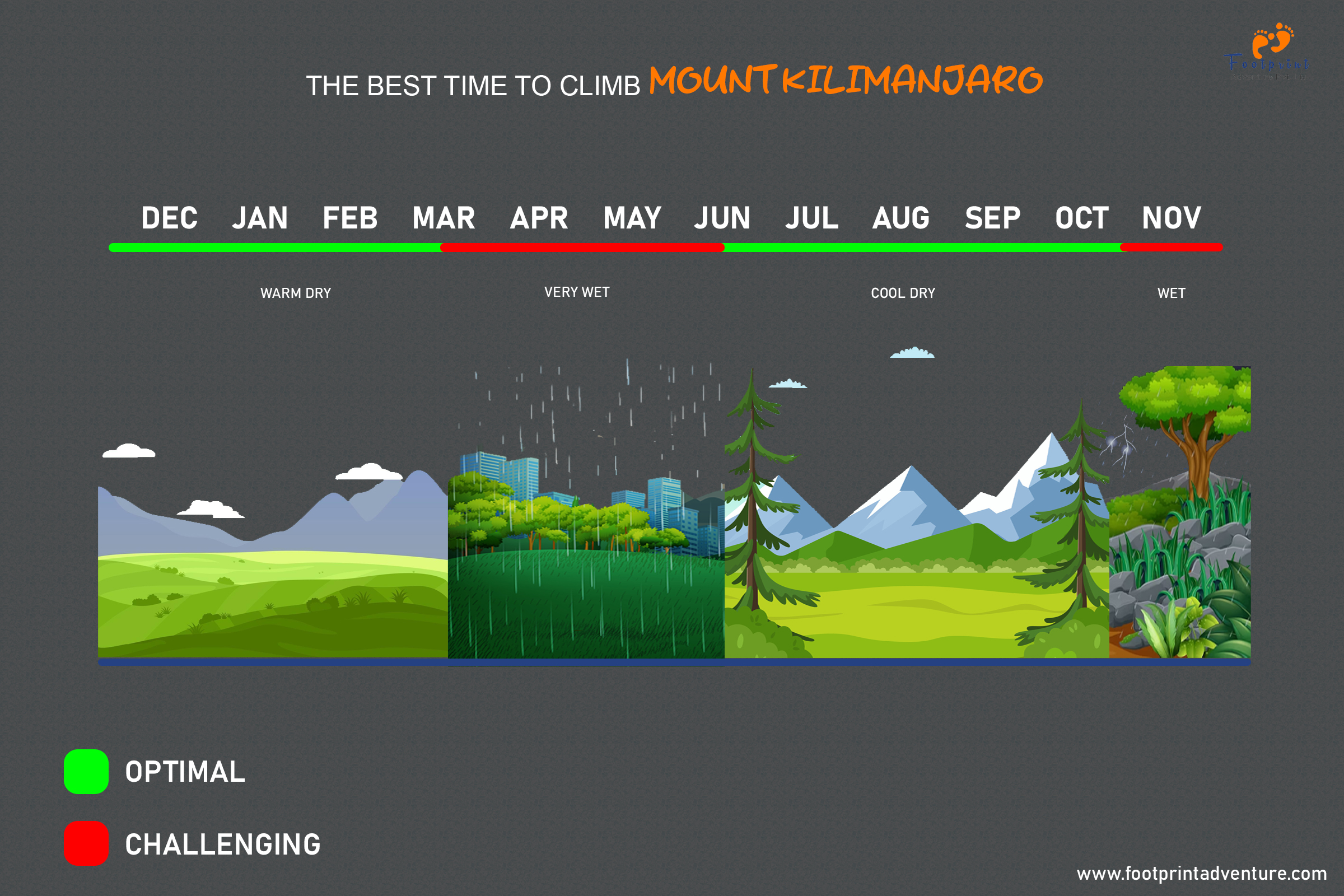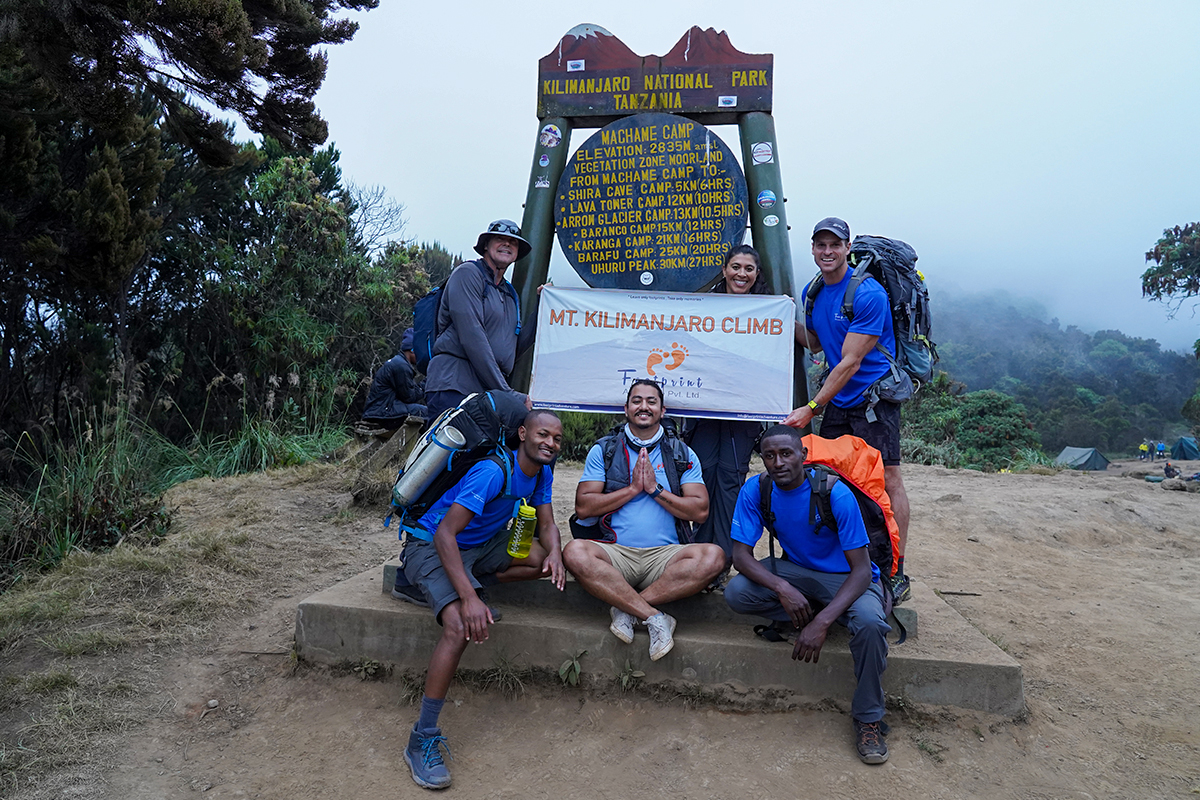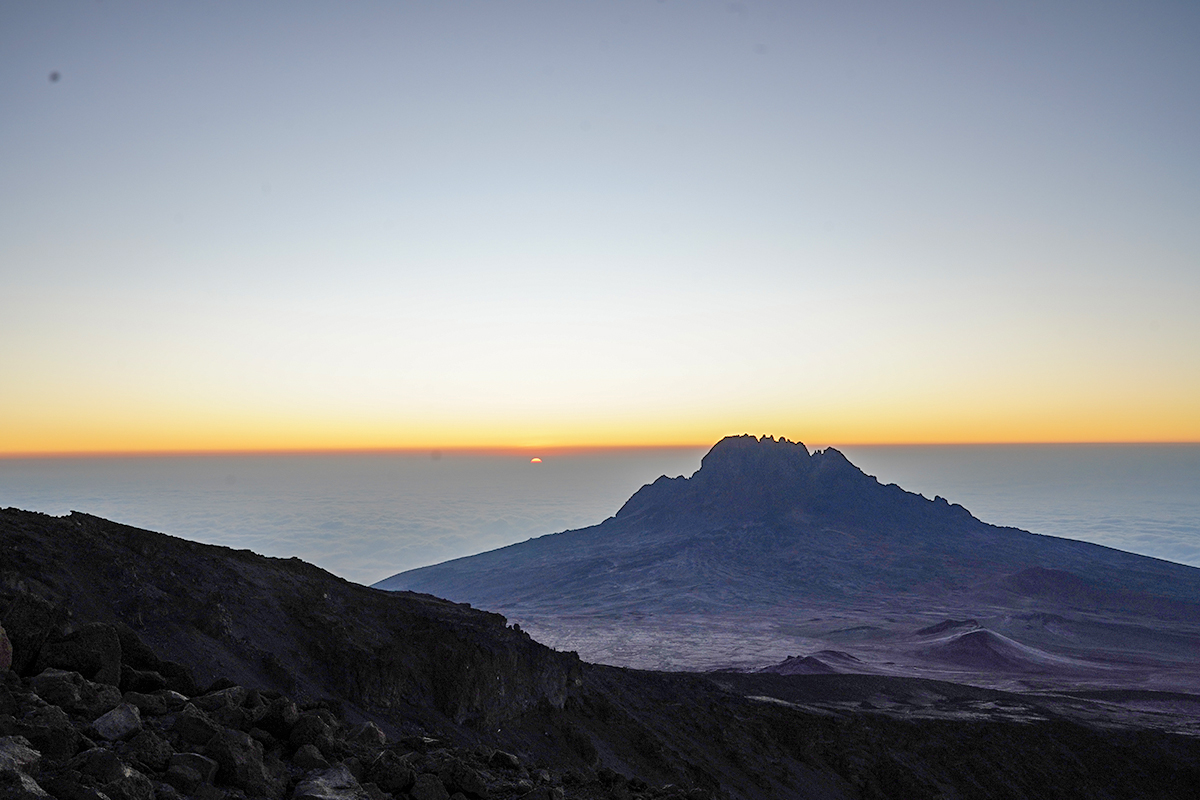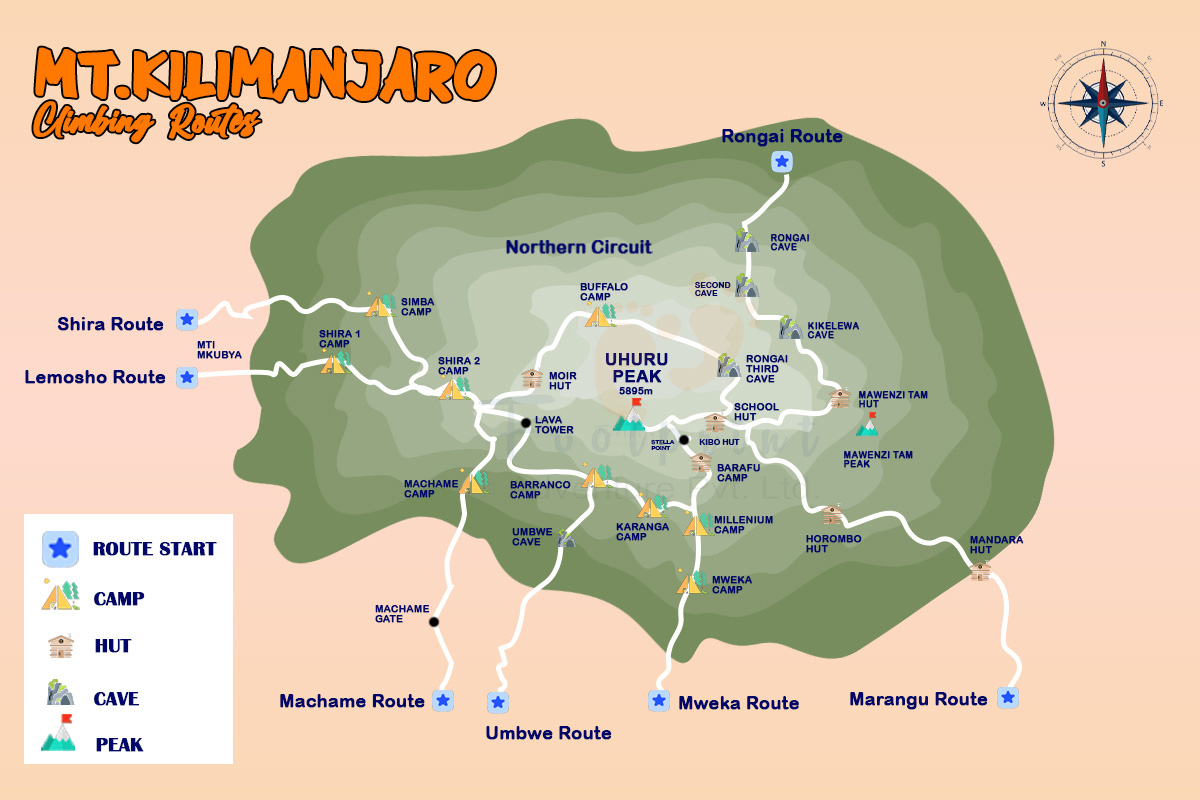Mount Kilimanjaro is the tallest mountain in Africa as well as the tallest free-standing mountain in the world. It stands at 5,895 meters (19,341 feet) which makes it one of the Seven Summits. Kilimanjaro is the highest point on the African continent. It is a dormant volcano in the Kilimanjaro National Park in Tanzania.
Kilimanjaro's climate is affected by its height, which lets equatorial trade winds and high altitude anti-trade winds affect it at the same time, as well as its location in a remote area. Kilimanjaro has both upslope and downslope winds. Downslope winds happen more often on the Southern side of the mountain than on the Northern side. The atmosphere is more severely impacted by the longer and flatter southern flanks.
At Kilimanjaro, there are two different rainy seasons; from March to May and from November to December. Rainfall on the northern slopes is significantly less than on the southern ones. On the lower southern slope, 800 to 900 millimeters (31 to 35 in) of precipitation fall each year. This amount increases to 1,500 to 2,000 millimeters (59 to 79 in) at 1,500 meters (4,900 ft) and peaks "partly over" 3,000 millimeters (120 in) in the forest belt at 2,000 to 2,300 meters (6,600 to 7,500 ft). In the alpine region, 7.99 inches of precipitation per year is found in the alpine region. The average temperature in the top region is around 7 °C (19 °F). On the northern ice field (NIF), the average low at night is 9 °C (16 °F), and the average high during the day is 4 °C (25 °F). During nights of intense radiational cooling, the temperature of the NIF can cool to as low as 15 to 27 °C (5 to 17 °F).
Although Mount Kilimanjaro in Tanzania can be climbed throughout the year, there are some months that are known for their lower temperatures, heavier rainfall, and even the possibility of significant snowfall on the summit. We typically suggest that the warmest and driest months of the year, which are December to mid-March and mid-June to the end of October, are the Best Seasons to Climb Mount Kilimanjaro. Despite the fact that these are the months with the best weather for mountain climbing, they are also the busiest.

We've broken down the Mount Kilimanjaro climbing season into off-peak times, times to avoid, and other things to think about to help you decide when the best Kilimanjaro climbing time for you:
Kilimanjaro Climb in January, February to early March
January and February are two of the Best Times to climb Mount Kilimanjaro, and thus the most popular season for climbing. Since these are the months with the highest average temperatures, you can anticipate a cloudless sky and sunny mornings and evenings. In the afternoons, however, you should be prepared for the possibility of light rain showers, as the weather in the mountains is always unpredictable. Conditions for hiking are nearly always dry and clear, allowing for excellent vision. There may be a few showers, and there is a good chance that it will snow above 14,000 feet elevation. This will make for some truly stunning photo opportunities for the photography enthusiastic.

Although this is considered to be "high season," it is typically much less busy on the slopes than during the major climbing season, which runs from June until September. As a result, this time of year strikes a good compromise between not being too crowded and having decent weather. Hikers who want to avoid large crowds but enjoy dry conditions may find this trail ideal. A pleasant surprise would be snow at the peak sometimes.
Kilimanjaro Climb in March, April, and May
Because of the long rainy season, which begins at the end of March and lasts until the beginning of June, because the paths can be quite muddy, snowy, and wet during this time, we do not advise climbing Kilimanjaro. You will not take advantage of the breathtaking views and photo ops if you climb in the rain, which is also likely to make the experience less enjoyable. However, if you do decide to go trekking at this time of year, you'll avoid the crowds at the campgrounds and on the trails (even the busiest trails may provide seclusion, calm, and tranquility). Some trekkers and climbers also like the idea of climbing Kilimanjaro when the top is likely to be covered in snow because it can make the climb harder and offer beautiful views at the same time. Besides this, this season brings an extra adventure for the adventure seekers.
Climbing Kilimanjaro in June
Because the wet season gives way to the dry season in June, this month has a tendency to have significantly less precipitation than March, April, and May do on average. However, you should be prepared for frigid weather, and the skies are often still hazy, so the views likely won't be as breathtaking as they otherwise could be. But with the precautions and proper guidance, you can still push for the top of Kilimanjaro.
Climbing Kilimanjaro in July, August, September, and October
The months of July through October are typically much drier than the months that came before them, despite the fact that the temperatures tend to be much lower during this time period. Even though there is a possibility of getting wet at any time of the year, particularly if you travel through the jungle or the moorlands, the amount of rain that falls is normally very small and it doesn't happen very often. If you can keep yourself dry throughout the journey, you will have a far better experience in terms of comfort and general pleasure. Climbing during these months has a lot of benefits, including the fact that the skies will be clear and sunny, giving you stunning views. For the photography enthusiast, these months can provide the stunning sights of landscapes and views of the rugged terrain.

The trails can become fairly crowded during these months, which is one of the drawbacks of going on a hike during this time, but some people enjoy the opportunity to talk to people from other groups while they are camped out. After all, having a strong sense of teamwork is absolutely necessary in order to reach the peak.
Climbing Kilimanjaro in November
The beginning of November marks the beginning of Tanzania's relatively brief rainy season, which lasts until the beginning of December. Rain is likely to fall in the late afternoon and last for a shorter period of time than it does during April and May ("the long rains"), but the mornings and evenings should be clear for you to enjoy the outdoors. It is not recommended to attempt a hike up Mount Kilimanjaro during this month because the weather can be extremely rainy, muddy, and slippery. We would advise taking either the Rongai route or the Northern Circuit route due to the fact that the northern side of the mountain is less exposed to the elements and receives less rainfall on average. Best for those who want to avoid crowds and are experienced hikers who aren't discouraged by inclement weather.
Climbing Kilimanjaro in December
Despite the fact that December is often when the short rainy season continues, many people choose to climb Mount Kilimanjaro during this month.
Kilimanjaro Climb during Full Moon
The top of Mount Kilimanjaro is particularly stunning during a full moon. The vistas are breathtaking as the bright moon illuminates the glaciers. Another benefit of going on a walk at this time of day is that the moonlight will make it easier for you to see, especially on your last ascent to Uhuru Peak. Many people like to reach Uhuru Peak when the moon is closest to full, even though it is not necessary to do so in order to benefit from moonlight.

A seven-day climb should begin five days before the full moon date, and an eight-day climb should begin six days before the full moon date if you do want to reach the summit on a full moon. Book early because these dates are incredibly popular and there are only a few spots available on the mountain at any one moment. We advise avoiding the full moon period entirely if you want a peaceful walk and a sky filled with beautiful stars.
Determine Which Kilimanjaro Trek Is Right for You
The Machame Route, the Lemosho Route, and the Rongai Route are the three routes that are considered to be the most popular ways to climb Mount Kilimanjaro. Each one comes with its own set of benefits and drawbacks:
The Machame Route
On the way up to Uhuru Peak, the well-known Machame Route provides hikers with a shorter but more difficult trip that lasts for a shorter amount of time overall. This route also features breathtaking views. To learn more, have a look at the detailed itinerary for our Mount Kilimanjaro Machame Trek. Learn more about the Machame Route
The Lemosho Route
Because the Lemosho Route is longer, more gradual, and less popular, but it is certainly not less beautiful, we highly recommend this route for people who are taking on the challenge of climbing Mount Kilimanjaro, particularly if you have little to no previous experience trekking. For more information, read the detailed itinerary for our Mount Kilimanjaro Lemosho Trek. Learn more about the Lemosho Route
The Rongai Route
The isolated Rongai Route reaches the summit of Kilimanjaro from the north, on the side of the mountain that is located in Kenya. In addition to the possibility of seeing large wildlife like antelope, elephants, and buffalo on these less-used trails, you have the choice of ascending more quickly or more gradually. Make direct contact with us if you have any questions regarding this itinerary.

FAQs
When is the Best time of the year to go climbing Kilimanjaro?
The shoulder seasons, right before and after the rains, are the times of year that are the least busy, so if you don't mind the potential of getting wet and are well-equipped, this is the best time of year to go. If you want to be by yourself on the mountain, it might be worth the potential downside of experiencing some rain if it means you'll have the entire peak to yourself. Climbing is not something that we do during the wettest parts of the year (April/May and November). Alternatively, you may go along one of the streets that see fewer people on foot. We propose that you take the trails on the northern side of the mountain during the rainy months because they receive less precipitation on average and are better protected from the elements.
Is climbing Kilimanjaro dangerous?
It is undoubtedly risky to climb a mountain that is 19,341 feet (5,895 m) high. Every year, an estimated 50,000 individuals attempt to climb Mount Kilimanjaro, 1,000 of whom are forced to be evacuated, and 10 of them die. It implies that the likelihood of dying on the mountain is essentially zero—0.0002%. In other words, the greatest cause of fatality is altitude sickness, and there is only one death for every 5,000 climbers.
Can I summit Kilimanjaro by myself?
No, and yes! It is feasible to climb Kilimanjaro alone, away from other trekkers and crowds. You will still receive assistance from porters and guides, though. As the Tanzanian Tourism Board forbids hiking without a guide, porter, and other crew members, even though you will be the sole trekker, you won't truly be alone. The ratio of hikers to support staff is 1:5, so if you're a solitary climber, four other trekkers from your organization will help you.

How cold is it at Kilimanjaro's summit?
The glacier zone, where the peak of Mount Kilimanjaro, also known as Uhuru Point, is located, has an average daytime temperature of roughly -6°C (21°F). All ascents, however, begin at about midnight in order to arrive at the Uhuru peak before daylight. Consequently, you will be trekking at night when the temperature drops to between -7 and -29°C (19 and -20°F).
Do I require oxygen to climb Mount Kilimanjaro?
Most people who try to climb Mount Kilimanjaro fail because they get sick from the high altitude. The body's reaction to the low oxygen levels in the environment is this illness. Even though you don't need oxygen to climb Mount Kilimanjaro, you might need extra oxygen if you get altitude sickness from a lack of oxygen while trying to reach the top. However, excessive use of oxygen may be extremely harmful to your health. If a person has altitude sickness at very high altitudes above 23,000 feet, they are usually given more oxygen. Also, the entire mountain is surrounded by dense rainforest, so there is enough oxygen in most of the camps. So, supplementary oxygen is normally not required but for the emergency case, your crew team will have a backup oxygen cylinder with them.
Is the Kilimanjaro climb more difficult than the journey to Everest Base Camp?
If you compare the Kilimanjaro climb to the Everest Base Camp Trek, you will find that the Kilimanjaro climb gets you to higher altitudes considerably more quickly. Depending on the route, it takes 4 to 6 days to ascend Mt. Kilimanjaro (19,341 ft) from Moshi (2,932 ft), which is a gain of more than 16,000 ft in elevation. According to statistics, the total success percentage for summiting Kilimanjaro is 65%, while the success rate for reaching Everest Base Camp is over 90%. So, climbing Kilimanjaro is harder than hiking to the Everest Base Camp in Nepal. This is especially true given that Kilimanjaro rises quickly and has a large elevation gain.

Is there much traffic on the Machame route?
Yes, the Machame route is more popular than the Marangu route these days due to the large number of experienced and novice climbers who are interested in climbing it. This means that the Machame route sees more traffic than the Marangu route, with many more climbers camped at the first campsites along the Machame route, Shira Camp, Barranco Camp, and Karanga Camp. Before attempting to reach the top of Kilimanjaro, climbers from the Machame, Lemosho, Shira, and Umbwe routes spend the night at Barafu. As more people use the beautiful Machame trail, it loses its wonderful and unique beauty.

What vaccinations do I need for Kilimanjaro?
Here are the recommended vaccinations if you are planning to visit Kilimanjaro:
- Hepatitis A and B
- Yellow Fever
- Typhoid
- Rabies
- Influenza










